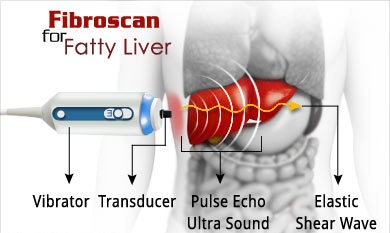Learn all about fibroscan test for liver fibrosis. Fibrosis occurs when excessive scar tissue builds up faster than it can be broken down and removed from the liver. Chronic infection with hepatitis C or hepatitis B virus (HCV or HBV), heavy alcohol consumption, toxins, trauma or other factors can all lead to liver fibrosis. Only in rare instances is liver fibrosis the primary problem; more often, it is secondary to some other liver disease such as cirrhosis.
FibroScan uses an ultrasound transducer, a probe placed between your ribs on your right side, on a small area of skin coated with a gel. The probe emits sound waves that pass through the liver and bounce back as shear waves. The stiffer the liver, the quicker the waves travel and the greater the degree of fibrosis. After 10 readings are taken, the total is averaged. The result is given in kilo Pascal’s (kPa).
The stage of liver disease can be estimated by measuring liver stiffness using a FibroScan. This scan is painless, takes less than ten minutes and produces immediate results. FibroScan has dramatically reduced the need for having a liver biopsy. Liver hardness is evaluated by measuring the velocity of a vibration wave (also called a ‘shear wave’) generated on the skin. Shear wave velocity is determined by measuring the time the vibration wave takes to travel to a particular depth inside the liver.
In hepatic fibrosis, excessive connective tissue accumulates in the liver; this tissue represents scarring in response to chronic, repeated liver cell injury. Commonly, fibrosis progresses, disrupting hepatic architecture and eventually function, as regenerating hepatocytes attempt to replace and repair damaged tissue. When such disruption is widespread, cirrhosis is diagnosed.
On the other hand, a very low FibroScan score can provide you and your loved ones reassurance that your liver can afford to wait for better/less expensive treatment options in the future. Recovery from liver fibrosis may lower your long term risk of cancer. FibroScan can show you how your recovery is advancing.
Fibrosis of the Liver
Fibrosis of the liver is excessive accumulation of scar tissue that results from ongoing inflammation and liver cell death that occurs in most types of chronic liver diseases. Nodules, abnormal spherical areas of cells, form as dying liver cells are replaced by regenerating cells. This regeneration of cells causes the liver to become hard. Fibrosis refers to the accumulation of tough, fibrous scar tissue in the liver.
Fibroscan Test
FibroScan is a non-invasive test to measure liver damage and often can be used in place of an invasive liver biopsy, where doctors use needles to collect samples of the liver. Mercy’s doctors specializing in liver and hepatobiliary disease use FibroScan to evaluate the severity of liver scarring and select the best treatment options for liver disease. Fibroscan uses elastography, which is a technique similar to ultrasound that measures the stiffness of your liver.
It is a non-invasive, painless alternative to liver biopsy and is used by our multi-disciplinary team at the Princess Grace Hospital for looking at liver damage from conditions such as Hepatitis C. It can be performed quickly and easily by one of our consultant hepatologists or specialist nurses who will be able to use the results to assess your condition, together with the results of your blood tests and any other diagnostic procedures you may have
Fibroscan Test Cost
A FibroScan alone costs $312. Total cost for the scan, a set of blood tests including liver function and a consultation with a Consultant Hepatologist is $395. Additional investigations including other blood tests would incur an extra fee”. There are similarities to a regular ultrasound, however the FibroScan results show whether there are any regions of scarring and how stiff your liver is and the results are displayed as readings, rather than as an image.
Fibroscan Test Score/Result
Fibroscan results range from 2.5 kPa to 75 kPa. Between 90–95% of healthy people without liver disease will have a liver scarring measurement less than 7.0 kPa (median is 5.3 kPa). FibroScan measures how quickly vibration waves pass through the liver. The more damaged or stiff the liver, the more rapidly the waves will pass through it. Results are presented as a number in kilopascals (kPa). A higher number indicates more liver damage. Results from FibroScan need to be interpreted based on other factors. However, a score of over 7.2 kPa indicates higher likelihood of significant fibrosis (F2 or greater on Metavir scale). A score over 14.5 kPa in someone with HCV/HIV coinfection indicates cirrhosis (F4 on the Metavir scale).
 Health & Care Information
Health & Care Information 


